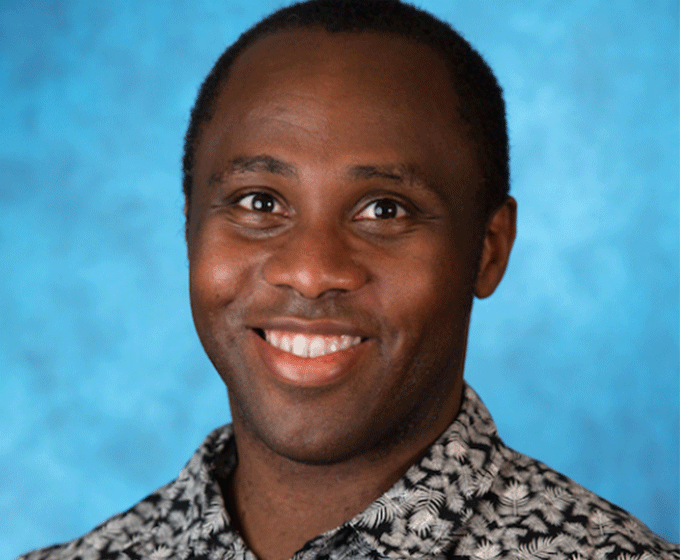
UTSA’s Richard Anantua specializes in reverse engineering near-horizon supermassive black hole observations. He modeled and simulated the plasma physics of Sagittarius A* that helped make an image of the black hole possible.
MAY 12, 2022 — Astronomers today unveiled the first-ever image of Sagittarius A*, the black hole that sits at the center of the Milky Way galaxy. This is only the second time in history that an image of a black hole has been captured. The first image was released in 2019, depicting the black hole at the center of the M87 galaxy.
Today’s discovery advances astrophysics research underway at UTSA. Richard Anantua, an assistant professor in the UTSA Department of Physics and Astronomy, is a theoretical astrophysicist specializing in reverse engineering near-horizon supermassive black hole observations.
He modeled and simulated the plasma physics of Sagittarius A* that helped make the image possible.
Anantua is a member of the EHT Collaboration, an international research team that uses its worldwide network of radio telescopes and a technique called interferometry which enables the telescope network to capture high-resolution data as if it were one Earth-sized telescope.

New findings provide overwhelming evidence that the center of the Milky Way galaxy is home to a massive black hole that is four million times more massive than our Sun, offering valuable insight into the inner workings of these cosmic entities. The Event Horizon Telescope Collaboration utilized its worldwide network of radio telescopes to provide this new image, which captures light bent by the powerful gravity of the black hole. Photo from EHT Collaboration
“This first image of light lensed immediately around the horizon of our own galaxy's supermassive black hole—and second black hole shadow image ever—is a landmark achievement in the history of astronomy,” Anantua said. “We can now directly probe strong gravity, and the spacetime effects of black hole mass, spin and charge, imposing some of the latest and most stringent tests of Einstein's theory of general relativity.”
The pioneering image was released today by astronomers in seven simultaneous worldwide press conferences.
“The Event Horizon Telescope has continued to push the frontiers of science and discovery,” said Dr. Karen Marrongelle, the National Science Foundation’s chief operating officer, today at a live broadcast announcing the new image. “This discovery was made possible by more than 300 researchers from 80 institutions working with eight different telescopes around the globe. Their achievement is a truly inspiring scientific endeavor and a powerful reminder of what we can achieve through international collaboration and coordination.”
To develop the image, teams of researchers tapped 3.5 petabytes of data from the eight telescopes, the same amount as about 100 million TikTok videos, and stored it on hard drives before combining, calibrating and converting into an image.
Afterward, the researchers shipped back hundreds of hard drives to Massachusetts and Germany, where supercomputers combined the signals, produced raw input data and calibrated it by combining it with data about the sensitivity of each telescope.
The imaging teams then processed the information to reconstruct the best possible images of the hot plasma surrounding the black hole. Researchers including Anantua also ran simulations predicting how material behaves around black holes the size of Sagittarius A*.
Anantua broadly specializes in theoretical cosmology, high-energy theoretical astrophysics, high-energy theoretical particle physics such as string theory and condensed matter theory. He develops plasma heating models to help researchers better understand the polarized emission around black holes. He modeled and simulated the plasma physics underlying the Sagittarius A* image.
“International partnerships, particularly ones as large and complex as the EHT Collaboration, fuels discovery and leads to breakthroughs in science,” said Bernard Arulanandam, vice president for research, economic development, and knowledge enterprise. “Dr. Anantua's scholarly contributions in space demonstrates how UTSA faculty are tackling grand challenges that have significance for all of humankind.”
Anantua earned his Ph.D. and M.S. in physics from Stanford University, his Ed.M. in education and policy management from Harvard University and two bachelor’s degrees from Yale University: one in physics and philosophy and the other in economics and mathematics.
In addition to his groundbreaking research contributions in physics, Anantua is committed to promoting physics as a career field to students of color. As the lead the EHT Outreach group, he coordinates with international press officers to publicize EHT science and connect the EHT Collaboration with diverse organizations including the National Society of Black Physicists. He is also developing the first EHT group based in Texas with Brandon Curd, a researcher who will begin a postdoctoral fellowship at UTSA this fall.
“Dr. Anantua is an exceptional faculty member who is not only making impactful research contributions but is also promoting science advocacy and outreach,” said UTSA College of Sciences Dean David Silva, adding that, “by serving a leadership role in the EHT Collaboration, Richard is utilizing his talents and strengths in innovative ways to build connections and pioneer new discoveries in the field of astrophysics.”
UTSA is a Tier One research university that is committed to tackling society’s grand challenges through world-class education and research programs. With an emphasis on transdisciplinary collaboration, innovation and entrepreneurship, it is leveraging its research and development capabilities to benefit the San Antonio community and the world beyond. The university currently spends $140 million each year, resulting in a powerful research and development ecosystem.
UTSA Today is produced by University Communications and Marketing, the official news source of The University of Texas at San Antonio. Send your feedback to news@utsa.edu. Keep up-to-date on UTSA news by visiting UTSA Today. Connect with UTSA online at Facebook, Twitter, Youtube and Instagram.
Move In To COLFA is strongly recommended for new students in COLFA. It gives you the chance to learn about the Student Success Center, campus resources and meet new friends!
Academic Classroom: Lecture Hall (MH 2.01.10,) McKinney Humanities BldgWe invite you to join us for Birds Up! Downtown, an exciting welcome back event designed to connect students with the different departments at the Downtown Campus. Students will have the opportunity to learn about some of the departments on campus, gain access to different resources, and collect some giveaways!
Bill Miller PlazaCome and celebrate this year's homecoming at the Downtown Campus with food, games, giveaways, music, and more. We look forward to seeing your Roadrunner Spirit!
Bill Miller PlazaThe University of Texas at San Antonio is dedicated to the advancement of knowledge through research and discovery, teaching and learning, community engagement and public service. As an institution of access and excellence, UTSA embraces multicultural traditions and serves as a center for intellectual and creative resources as well as a catalyst for socioeconomic development and the commercialization of intellectual property - for Texas, the nation and the world.
To be a premier public research university, providing access to educational excellence and preparing citizen leaders for the global environment.
We encourage an environment of dialogue and discovery, where integrity, excellence, respect, collaboration and innovation are fostered.